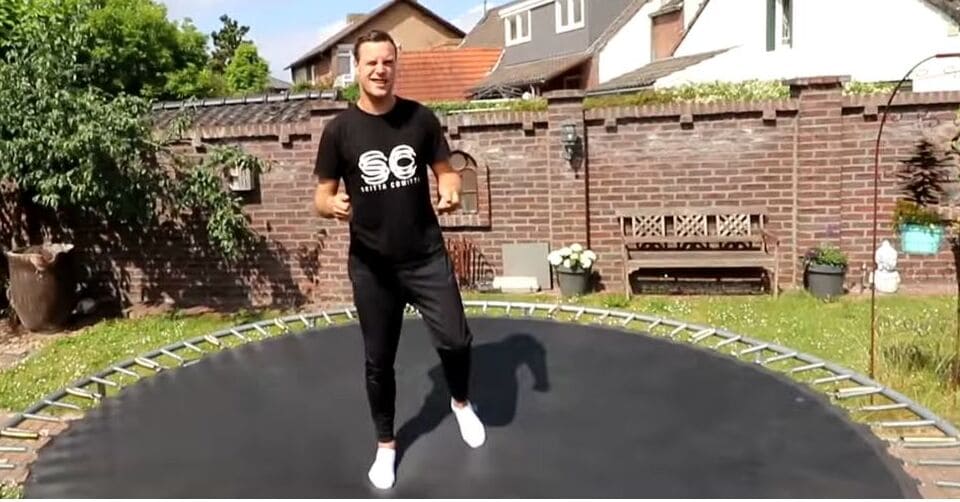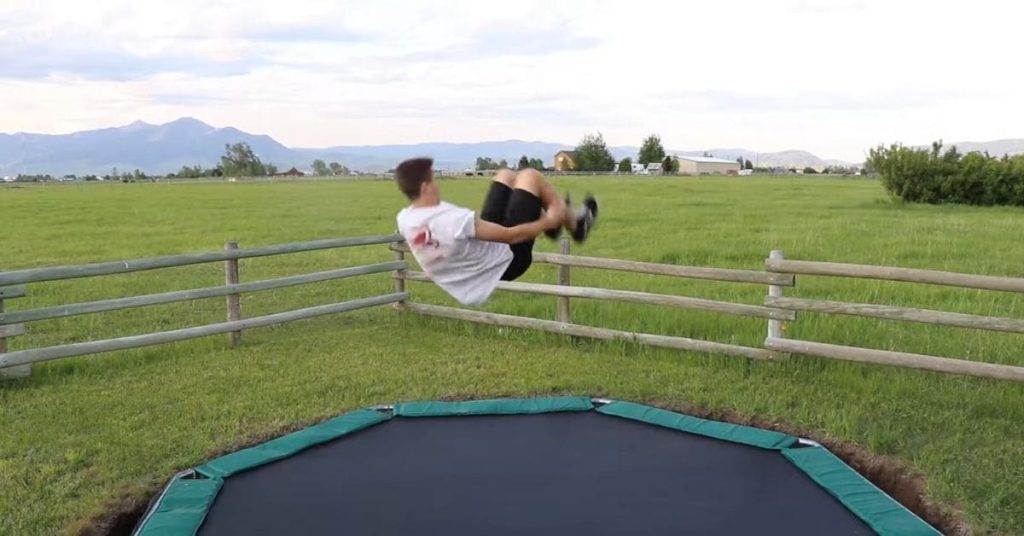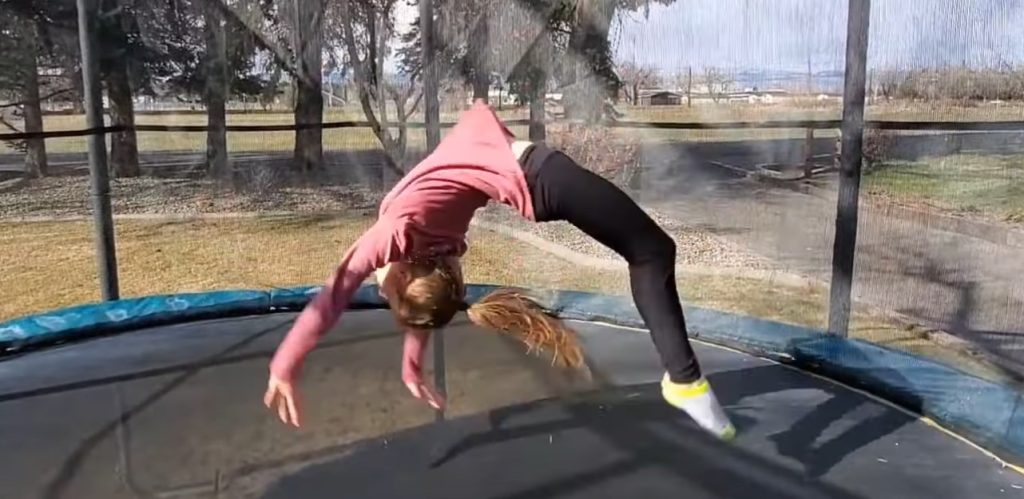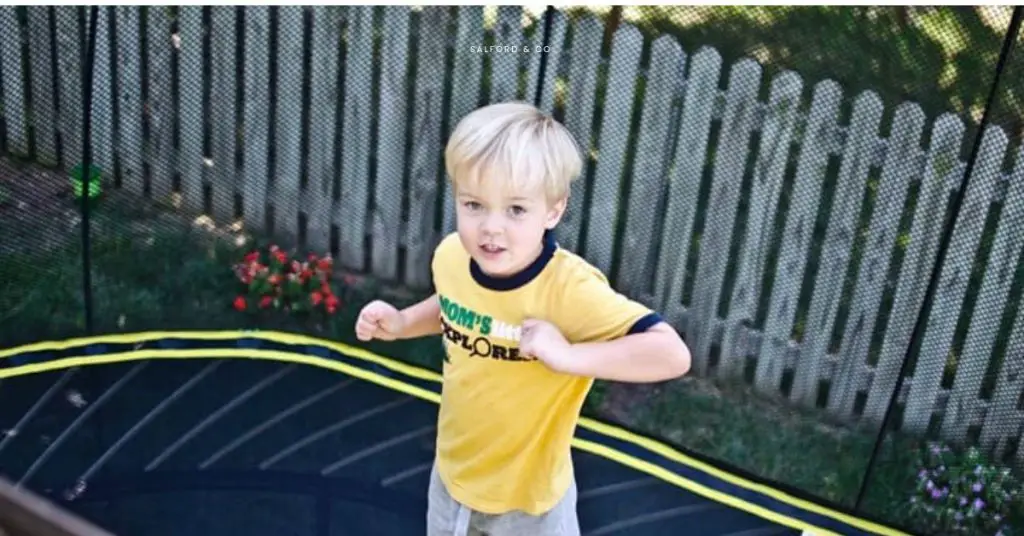Trampolines have long been a popular source of exhilarating fun and physical activity. Trampolines offer a unique way to experience the joy of defying gravity, whether bouncing, flipping, or performing gravity-defying stunts.
However, regarding safety precautions, questions about the appropriate attire for trampoline use often arise. One particular query frequently emerges is whether wearing shoes on a trampoline is permissible.
The issue of wearing shoes on a trampoline involves a careful balance between comfort, safety, and performance. While trampolines are designed to provide a soft and springy surface, including shoes introduces additional factors that must be considered.
This inquiry prompts discussions about the risks associated with wearing shoes on a trampoline, including potential damage to the trampoline mat, decreased grip and stability, and increased likelihood of injury to oneself and others.
In this article, we will delve into the topic of wearing shoes on a trampoline, examining the pros and cons, safety considerations, and alternative options.
By exploring various perspectives and expert opinions, we aim to comprehensively analyze whether wearing shoes on a trampoline is advisable or if alternative footwear choices should be favored. So, let’s dive in and uncover the truth about wearing shoes on a trampoline.
Can You Wear Shoes On A Trampoline? It is generally not recommended to wear shoes on a trampoline as they can damage the trampoline mat and increase the risk of injury to the user and others.
Can you wear shoes on a trampoline?

Wearing shoes on a trampoline is risky and can harm the mat. If you put on heavy-duty shoes or sneakers made for walking on roads, the jumping mat can wear out too soon because of more rubbing against it. Text the trampoline mat from getting damaged early.
Why You Shouldn’t Wear Shoes on a Trampoline
Trampolines are a popular source of entertainment and exercise for people of all ages. They provide an exhilarating experience that allows you to bounce, jump, and perform various acrobatic maneuvers.
While trampolining is fun, it’s important to be aware of potential risks, particularly when wearing shoes on a trampoline.
we will explore the reasons why you shouldn’t wear shoes on a trampoline and delve into the importance of preventing injuries and preserving the trampoline mat.
Preventing Injuries
Jumping on a trampoline with shoes can significantly increase the risk of various injuries. Bouncing on a trampoline requires balance, coordination, and precise movements. Wearing shoes alters the natural dynamics of your feet and affects your ability to maintain proper form and control while jumping.
Exploring the Dangers of Wearing Shoes While Jumping
One of the primary dangers of wearing shoes on a trampoline is the increased risk of ankle sprains and fractures. Shoes are designed with rigid soles that restrict your feet’ natural range of motion. When you bounce on a trampoline, the impact is absorbed by your feet and distributed throughout your body.
The strain on your ankles can become excessive without the natural flexibility and shock absorption provided by bare feet. This can lead to a higher likelihood of ankle twists, sprains, and even fractures.
Preserving the Trampoline Mat
Another reason why wearing shoes on a trampoline is discouraged is the potential damage it can cause to the trampoline mat. The mat is a crucial trampoline component that supports your weight and provides the necessary bounce.
The soles of shoes, especially those with rough treads or outdoor debris, can create friction against the mat’s surface. This friction leads to wear and tear, weakening the mat’s integrity over time.
Discussing the Potential Damage Caused by Shoe Wear and Tear
Regular use of shoes on a trampoline accelerates the deterioration of the mat. The abrasive texture of shoe soles and the repetitive bouncing motion causes the mat’s surface to degrade faster.
As the mat wears down, it cannot provide a consistent and safe bouncing experience. This can result in a reduced bounce, decreased shock absorption, and potential tearing of the mat.
Factors Leading to Premature Trampoline Mat Replacement
Wearing shoes on a trampoline increases the frequency and severity of wear and tear on the mat, leading to premature replacement. Trampoline mats are designed to withstand regular use, but the added strain from shoes can significantly reduce their lifespan.
Premature mat replacement can be costly and inconvenient. By avoiding shoes used on the trampoline, you can extend the mat’s lifespan and ensure a safer and more cost-effective trampoline experience.
Can You Jump on a Trampoline with Shoes?

Trampolines are a popular recreational activity that offers endless fun and fitness benefits. When it comes to using a trampoline, there is an ongoing debate about whether jumping with shoes on is safe.
we will explore this question and emphasize the importance of safety by understanding recommended guidelines. Additionally, we will delve into what might be hiding on the bottom of your shoes and examine the impact it can have on the hygiene and cleanliness of the trampoline.
Safety First: Understanding the Recommended Guidelines
Trampoline manufacturers and safety experts typically recommend jumping on a trampoline without shoes.
This guideline is primarily based on safety considerations. Jumping barefoot allows for a better grip and connection between your feet and the trampoline mat, enabling you to maintain better balance and control while jumping.
Your feet’ flexibility and natural movement also reduce the risk of ankle twists or other injuries.
What Is Hiding on the Bottom of Your Shoes?
Have you ever wondered what your shoes might carry from the outside world onto the trampoline? Well, it’s not just dirt or dust. Shoes can track in various debris, such as grass, mud, small rocks, and potentially harmful substances like chemicals or sharp objects.
When you jump with your shoes on, these foreign objects can be transferred onto the trampoline mat, creating potential hazards.
Examining the Dirt, Debris, and Foreign Objects Shoes May Bring onto the Trampoline
The accumulation of dirt, debris, and foreign objects on the trampoline mat can pose safety risks. When you jump on a trampoline, these particles can become dislodged and get in the way of your movements.
They may cause discomfort or even lead to slips and falls. Small rocks or sharp objects can also puncture or damage the trampoline mat, compromising its integrity and safety.
Impact on Hygiene and Cleanliness
Jumping on a trampoline with shoes also has implications for hygiene and cleanliness. Trampolines are often shared among family members or friends, and the accumulation of dirt and debris can contribute to an unsanitary environment.
Bacteria and germs can thrive in these conditions, potentially causing infections or illnesses. You can maintain a cleaner and more hygienic trampoline surface by jumping barefoot or with appropriate trampoline socks.
Is it safe to use flip-flops while jumping on a trampoline?
Just like regular shoes and boots, flip-flops are not safe to wear on a trampoline. They are not secure on the feet, and it’s easy for kids to slip or trip while jumping, leading to injuries.
To stay safe, kids should wear stable, lightweight, and flexible footwear while on the trampoline. This helps reduce the risk of accidents.
Is it safe to wear socks while using a trampoline?
It’s usually best to jump on a trampoline without wearing any shoes or socks. However, if it’s too hot or you want to protect your feet, you can wear special non-slip socks with rubber soles made for trampolines.
These socks provide a better grip and reduce the chances of slipping or sliding while jumping. Look for trampoline socks designed specifically for this purpose.
Experiencing the Full Benefits of the Trampoline
Trampolines offer a fantastic way to have fun while improving fitness and coordination. While some people may wonder if jumping barefoot on a trampoline is the best option, it comes with several advantages.
We will explore the benefits of jumping barefoot, including the importance of sensory feedback, improved balance, and strengthened foot and ankle muscles.
Advantages of Jumping Barefoot
Jumping on a trampoline without shoes provides a more authentic and natural experience. Going barefoot allows your feet to make direct contact with the trampoline mat, enhancing your connection to the surface.
This direct contact creates a unique sensory experience that allows you to fully immerse yourself in the bouncing sensation.
Importance of Sensory Feedback and Improved Balance
Jumping barefoot on a trampoline provides valuable sensory feedback crucial to improving balance and coordination. The nerve endings on the soles of your feet are highly sensitive and help to relay information to your brain about your body’s position and movements.
When you jump barefoot, you receive instant feedback from the trampoline mat, enabling you to adjust and maintain better balance.
Additionally, the improved sensory feedback obtained from jumping barefoot enhances proprioception—the awareness of your body’s position in space. This heightened sense of proprioception leads to better overall coordination and body control while bouncing on the trampoline.
Strengthening Foot and Ankle Muscles
Jumping on a trampoline barefoot provides an excellent opportunity to strengthen the muscles in your feet and ankles. Unlike when wearing shoes, jumping without footwear allows your feet to move freely and naturally.
The muscles in your feet and ankles are actively engaged as they work to stabilize and control your movements on the trampoline. Over time, this can increase strength, stability, and flexibility in these areas.
Strong foot and ankle muscles contribute to better performance on the trampoline and have benefits beyond the activity itself. They can enhance your overall balance and stability in various daily activities and sports, reducing the risk of injuries.
What to Wear Instead of Shoes on the Trampoline

When jumping on a trampoline, wearing the right footwear is essential for safety and optimal performance. While jumping barefoot is popular, alternative options provide added comfort and protection.
We will explore what to wear instead of shoes on the trampoline, including socks or specialized trampoline shoes. We will also emphasize the importance of proper fit and grip to ensure a safe and enjoyable bouncing experience.
Alternative Options for Footwear
Socks: Many trampoline enthusiasts prefer wearing socks while jumping. Socks offer a layer of cushioning and can help prevent friction between your feet and the trampoline mat. Opt for socks with a good grip on the sole to enhance traction and reduce the risk of slipping.
Trampoline Shoes: Specialized trampoline shoes are designed specifically for trampolining. These shoes typically feature lightweight and flexible materials for better movement and control.
Trampoline shoes often have non-slip soles with enhanced grip, providing optimal traction on the trampoline mat. They offer a balance between protection and the freedom of movement required for trampolining.
Ensuring Proper Fit and Grip for Safety
Whether you wear socks or trampoline shoes, it’s crucial to ensure a proper fit to maintain safety while jumping. Ill-fitting footwear can impede your movements and increase the risk of accidents. Here are a few considerations:
Size: Select socks or trampoline shoes that fit snugly but not too tight. Avoid too loose footwear, as it may slide or come off during vigorous bouncing.
Grip: Look for socks or trampoline shoes with grippy soles. The footwear’s traction is essential to prevent slipping and maintain stability on the trampoline mat.
Flexibility: Choose footwear that allows for natural foot movement. The flexibility of the socks or trampoline shoes is crucial for proper balance and control while performing various jumps and maneuvers.
Support: While trampoline shoes provide better support than regular socks, consider your individual needs. Consult a healthcare professional to determine the best option if you have specific foot or ankle conditions.
Appropriate footwear can enhance your trampolining experience and reduce the risk of injuries. Whether you prefer socks or specialized trampoline shoes, prioritize comfort, fit, grip, and flexibility to ensure optimal performance and safety.
Public Trampolines and Other Safety Measures
Trampolines are enjoyed in private settings and can be found in public spaces such as trampoline parks and recreational facilities. Regarding public trampolines, specific policies and guidelines are in place to ensure participants’ safety.
we will discuss the policies regarding footwear on public trampolines, explore additional safety products that can enhance the trampolining experience, and highlight the importance of supervision and safety guidelines.
Policies Regarding Footwear on Public Trampolines
Public trampoline parks often have specific policies regarding footwear to maintain a safe environment for all participants. While policies may vary from one facility to another, many require participants to remove their shoes before entering the trampoline area.
This policy is in place to prevent damage to the trampoline mats, maintain cleanliness, and reduce the risk of slipping or tripping.
In addition to shoes, some trampoline parks may also prohibit using socks, as they can create slippery surfaces when combined with the trampoline mat. However, it’s essential to check the specific rules and recommendations of the trampoline park you plan to visit, as policies can differ.
Additional Safety Products for Trampolines
Aside from footwear policies, additional safety products can be used to enhance the trampolining experience and reduce the risk of injuries. These safety products are designed to provide extra protection and promote safe bouncing. Here are a few examples:
Safety Pads: Trampoline safety pads are foam covers placed over the trampoline’s frame and springs. They provide cushioning and help prevent accidental contact with the hard components of the trampoline, reducing the risk of injuries.
Safety Nets: Trampoline safety nets are installed around the perimeter of the trampoline to create a protective enclosure. They act as a barrier, preventing users from accidentally bouncing or falling off the trampoline, significantly reducing the risk of serious injuries.
Anchoring Systems: Trampoline anchoring systems secure the trampoline to the ground, preventing it from tipping or moving during use. Anchoring the trampoline adds stability, particularly in outdoor settings where wind or uneven ground poses safety hazards.
Highlighting the Importance of Supervision and Safety Guidelines

While policies and safety products are essential, they should always be accompanied by proper supervision and adherence to safety guidelines.
Trampolining, especially in public settings, requires responsible participation and awareness of the rules. Some key safety guidelines to keep in mind include the following:
Following Age Restrictions: Trampoline parks often have age restrictions to ensure the appropriate use of the equipment. Adhere to these guidelines and encourage children to use trampolines suitable for their age and skill level.
Avoiding Overcrowding: Public trampoline parks may have specific capacity limits to prevent overcrowding and minimize the risk of collisions or accidents. Respect these limits and allow enough space for safe bouncing.
Proper Jumping Techniques: Encourage proper jumping techniques, such as jumping in the center of the trampoline, avoiding somersaults or flips without proper training, and not attempting risky maneuvers beyond your skill level.
Supervision: Active supervision by trained staff is crucial in public trampoline parks. They can provide guidance, enforce safety rules, and respond promptly in case of emergencies.
Can You Use a Trampoline Barefoot?
When using a trampoline, one common question is whether jumping barefoot is safe and advisable. Jumping on a trampoline without any footwear can have both pros and cons.
we will explore the advantages and disadvantages of using a trampoline barefoot and the importance of understanding individual preferences and comfort levels.
Pros of Jumping Barefoot on a Trampoline
Enhanced Sensory Experience: Jumping barefoot on a trampoline allows direct contact between your feet and the trampoline mat. This direct connection enhances the sensory experience, giving you a better feel for the trampoline’s bounce and improving your overall connection to the surface.
Improved Balance and Control: Going barefoot can enhance your balance and control while jumping on the trampoline. The nerve endings on the soles of your feet provide valuable feedback to your brain about your body’s position and movements. This heightened sensory input helps you adjust in real time, leading to better balance and control.
Strengthening Foot and Ankle Muscles: Jumping without shoes allows your feet and ankle muscles to work more actively and naturally. The muscles in your feet and ankles are engaged as they stabilize and control your movements on the trampoline. Over time, this can increase strength, stability, and flexibility in these areas.
Cons of Jumping Barefoot on a Trampoline
Lack of Cushioning: One potential drawback of jumping barefoot is the absence of cushioning between your feet and the trampoline mat. Some individuals may find that the impact on their joints and feet is more noticeable without the additional padding provided by shoes or socks.
Hygiene and Cleanliness Concerns: Trampoline mats can accumulate dirt, debris, and harmful bacteria over time. Jumping barefoot exposes your feet to these elements, which may increase the risk of infections or irritations. Ensuring that the trampoline mat is clean and regularly maintained is crucial to minimize these concerns.
Understanding Individual Preferences and Comfort Levels

The decision to use a trampoline barefoot ultimately depends on individual preferences and comfort levels. Some people find jumping without shoes liberating and enjoyable, benefiting from enhanced sensory feedback and improved balance.
Others may prefer the additional cushioning and protection socks or specialized trampoline shoes offer.
When deciding whether to jump barefoot on a trampoline, it’s important to consider personal factors such as foot sensitivity, previous injuries, and overall comfort. If you go barefoot, ensure that the trampoline surface is clean, free from sharp objects, and well-maintained to reduce the risk of injuries and infections.
Should you wear socks on a trampoline?
It is generally not recommended to wear socks on a trampoline. Socks can reduce traction and grip, making slipping and losing balance easier while bouncing. This can increase the risk of injury, especially when attempting more advanced moves.
However, if socks are worn, they should have a good grip and be made specifically for trampoline use. It is also important to ensure the trampoline surface is dry and free of debris. Ultimately, bouncing on a trampoline without socks is safer, providing better control and reducing the risk of slipping or falling.
Related article: How Much Does The Trampoline Park Cost
FAQs:
Q.1 Can I wear shoes while jumping on a trampoline?
It is generally recommended not to wear shoes on a trampoline. Wearing shoes can increase the risk of injury, as the soles may damage the trampoline mat or cause slippage during jumps.
Q.2 Why should I avoid wearing shoes on a trampoline?
Shoes can have hard or abrasive soles that can damage the trampoline mat, springs, or padding. They can also compromise the trampoline’s bounce and stability. Furthermore, shoes may increase the chances of slipping or losing balance, leading to potential injuries.
Q.3 What footwear should I use on a trampoline?
It is best to jump barefoot or wear trampoline-specific socks designed to provide traction and reduce the risk of slipping. Trampoline shoes or grippy athletic socks with rubber soles are also suitable alternatives.
Q.4 Are there any exceptions to wearing shoes on a trampoline?
In certain cases, such as a foot injury or a medical condition requiring footwear, you may need to wear shoes on a trampoline. In such instances, ensure that your shoes have non-marking soles and are free from sharp or protruding objects.
Q.5 Should you wear shoes on a mini trampoline?
Going barefoot or wearing specific trampoline socks with grip is generally recommended. This allows for better balance and control while reducing the risk of slipping or accidents.
Q.6 Can you wear tennis shoes on a trampoline?
While you can wear tennis shoes on a trampoline, it is not recommended. Tennis shoes are designed for different surfaces and may not provide sufficient grip on a trampoline, increasing the risk of slipping or losing balance.
Q.7 What kind of shoes should you wear to a trampoline park?
Many trampoline parks require participants to wear trampoline socks with grip to ensure safety and prevent damage to the trampolines. These specialized socks are designed to provide traction and protect the trampoline surface.
It is important to check the specific rules and guidelines of the trampoline park you plan to visit to ensure you have the appropriate footwear.
Conclusion:
In conclusion, wearing shoes on a trampoline is not recommended for several reasons. Firstly, it can lead to injuries as shoes provide less grip and stability, increasing the risk of slipping or twisting an ankle. Moreover, wearing shoes can damage the trampoline mat due to increased friction, leading to premature wear and tear.
It is crucial to prioritize safety by following recommended guidelines, which advise against wearing shoes while jumping on a trampoline. Additionally, shoes can bring dirt, debris, and foreign objects onto the trampoline, affecting its cleanliness and hygiene.
On the other hand, jumping barefoot on a trampoline offers advantages such as improved balance, strengthened foot and ankle muscles, and better sensory feedback. If you prefer to wear something, there are alternative options like specialized trampoline socks or well-fitting footwear with good grip.
Public trampolines often have policies regarding footwear to ensure safety, and it is essential to adhere to these guidelines. Lastly, supervision and adherence to safety measures are crucial to prevent accidents and enjoy the full benefits of trampolining.
Do we trust that this detailed guide on Can You Wear Shoes On A Trampoline? It is generally not recommended to wear shoes on a trampoline as they can damage the trampoline mat and increase the risk of injury to the user and others. has provided you with valuable insights. If you have any further inquiries, please don’t hesitate to leave a comment below.

